Should You Microchip your Cat or Dog?
If your dog or cat became lost or could not be located in a storm, thereís a
strong possibility that you might never see him again. Thatís why itís important
to microchip your pet if you want to increase the possibility for recovery.
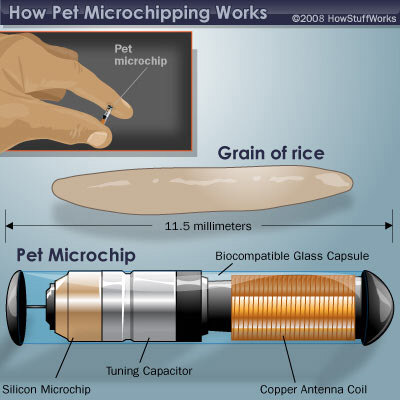
An Electronic Pet ID
Microchipping is an inexpensive measure that electronically IDs your cat or
dog. Information can be obtained by the use of a handheld scanner. Similar in
size to a small grain of rice, the minuscule chip is manufactured within a
glass-type covering that can be injected into an animalís tissue.
Radiograph of a Pet Cat with an Identifying Microchip:
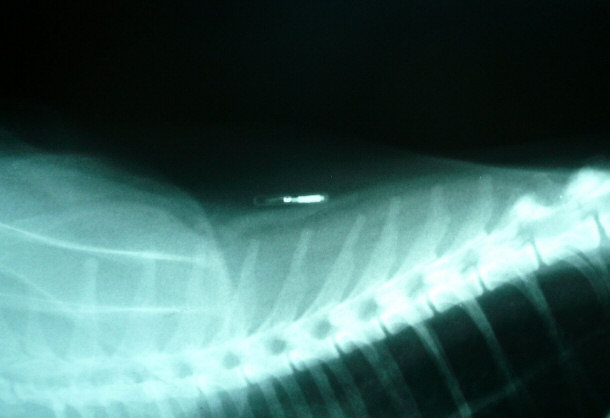
By Joelmills
via Wikimedia Commons
Usually, a vet
will implant the device between the shoulder blades of the animal or at the
scruff of the neck on a dog or cat.
Inserting the Chip
The microchip process itself can be likened to receiving a vaccination. Pain
is minimal, if hardly noticed, when the chip is being injected by a vet. A
specialized syringe is used to insert the chip.
Learn More About Chip Insertion by Viewing the Following Video:
The Details on the ID Can Be Referenced upon Microchip Registration
Once the chip has been inserted, the computerized I.D. can be scanned with a
handheld device which reveals an alphanumeric code. The ID can be accessed and
referenced after your pet is registered with a microchip company.
A Permanent Form of ID
Once the microchip has been placed, itís permanent. Therefore, microchips
never need replacement nor do they require charging. However, that being said,
some chips have been reported to move elsewhere within a catís or dogís body
after they were inserted.
Most Shelters and Veterinarian Clinics are Equipped with Scanners for
Identifying Microchipped Animals
Still, possible migration of the chip should not present a concern. People
who scan pets for the IDs are instructed to scan the entire body of the animal,
not just the area where the ID is usually placed.
RFID Scanner Used to Register the Identifying Microchipped
Animals:
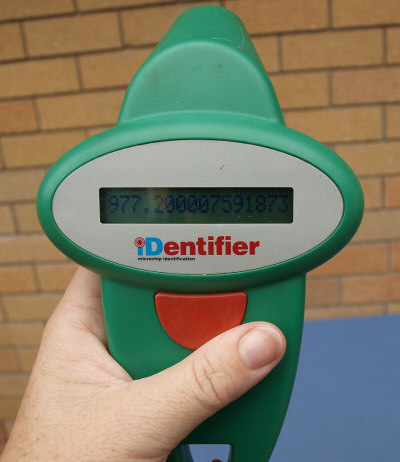
If a missing dog or cat ends
up at an animal shelter then, most of these facilities are equipped with the
knowledge and technology to ID the animals.
Improve the Chances that Your Pet Will be Found by Mircrochipping Him
While not every facility has a scanner and not all scanners work with certain
microchips, that doesnít mean you shouldnít microchip your dog or cat.
Statistics show that microchipped animals are recovered about 75% of the time.
Device that Is Implanted in Your Pet and a Grain of Rice
for Size Comparison:
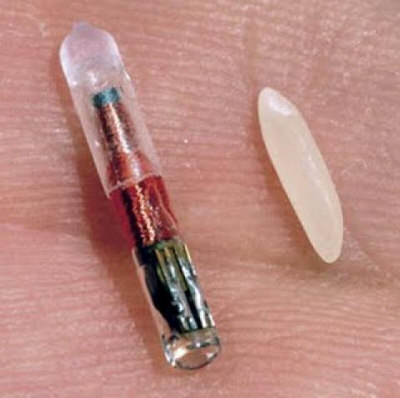
Pets who only wear tags are recovered about 10% of the time.
Make Sure to Register Your Pet Once He is Microchipped
After you have your pet microchipped, again, you'll need to register him. The
details that are conveyed will be included on a national database of the chosen
registry. If you pet doesn't make it into the database then if the dog is found
and ends up at either a veterinarian's office or the local kennel, there will be
no way of letting you know that your favorite family member was found.
Veterinarian Scanning and Verifying a Dog's Identity:
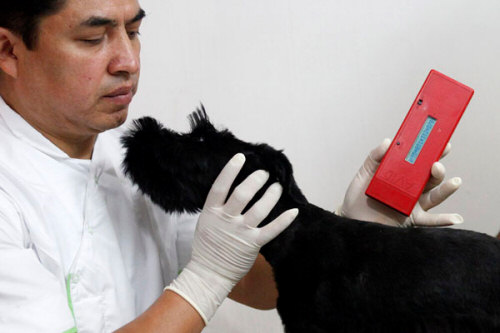
So, make sure you register your pet. Otherwise, you'll defeat the
whole purpose of obtaining the electronic identification in the first place.
Safeguard Your Pet with an Electronic ID
Unfortunately, around six million dogs and cats are placed in shelters each
year. Of that amount, around 3 to 3.5 million animals are euthanized.

Not
only does microchipping ensure the recovery of a lost pet, it also assists in
keeping him safer and more secure as well.
Pets
Top Lists:
18 Richest Animals in the World
15 Exotic Pets You Could Own Today
Top 20 Common Substances That Are Toxic to Cats and Dogs
Informational:
Animal Actors: Pets in the Film, TV, and Print Industry
Caring for a Yorkshire Terrier: Facts You Should Know
Caring for a Pig as a Pet: The Pot-bellied Pig and the Micro Pig
Difference Between a Cat Person And a Dog Person
Should You Microchip your Cat or Dog?
How to Raise and Care for Pygmy Goats
Caring for Unique Pets: The Leopard Gecko
Use Food-Grade Diatomaceous Earth to Kill Fleas Naturally
Dogs:
Top Lists:
Top 15 Dog Breeds For Home Protection
15 Fascinating Facts About The Mastiff
Informational:
How To Teach Your Dog to Hunt for Truffles
Caring for an English Bulldog: Tips and Basic Info
Cranial Cruciate Ligament (CCL) Tears in Dogs: Treating the Injury
How To Keep Your Dog free of Heartworm Disease
Dog With Separation Anxiety?
Cats:
Top Lists:
Top 6 Qualities in an Awesome Cat
Informational:
How to Control Fighting Felines
How to Get Your Cat to Exercise
Fish:
Fish 101 for the Hobbyist: The Fishís Body and Senses
Buying a Saltwater Aquarium: What You Need to Know
Graduating to a Saltwater Tank
|